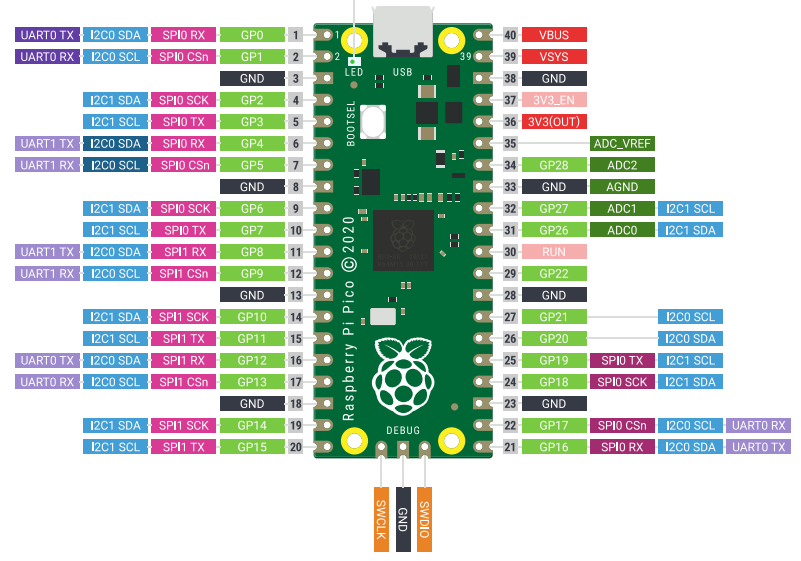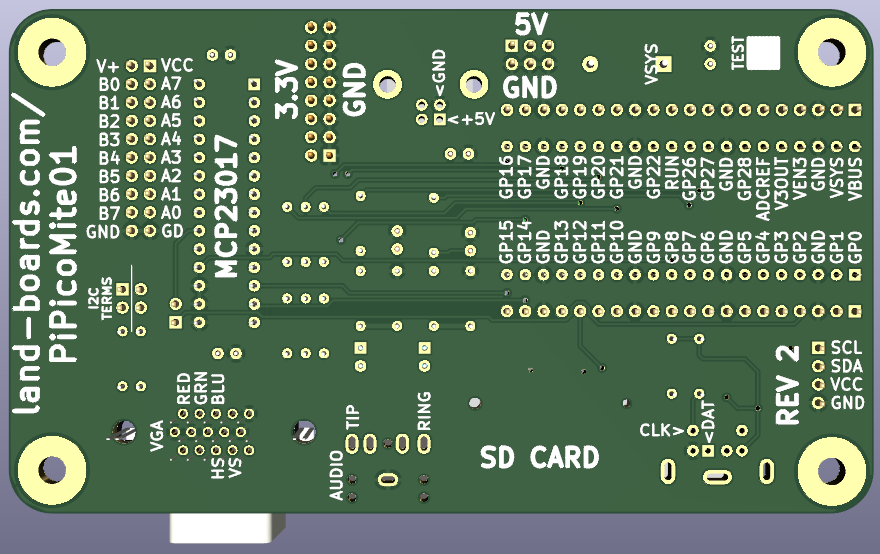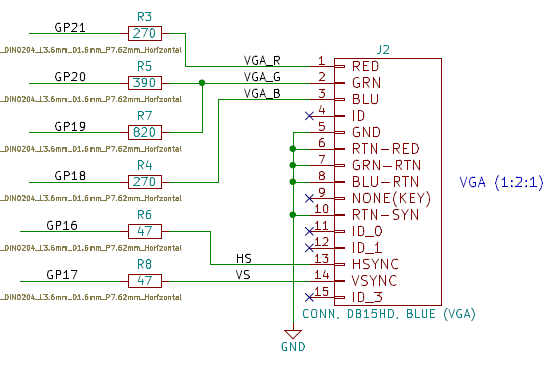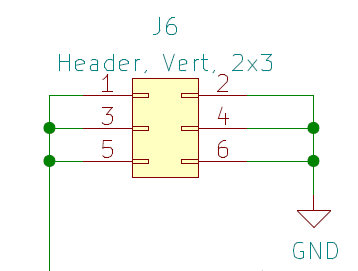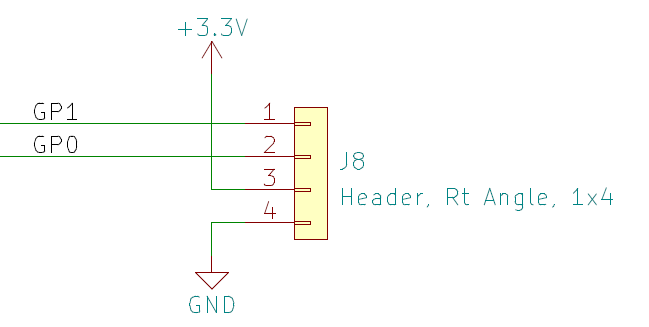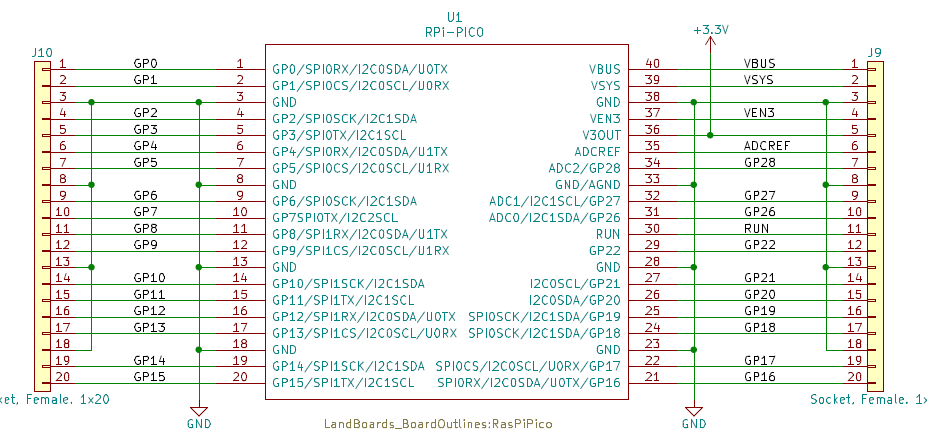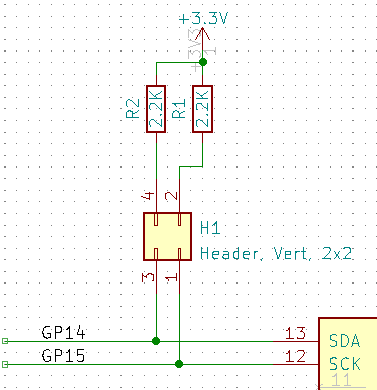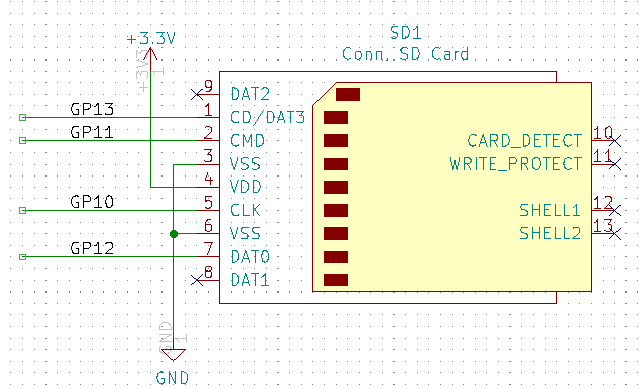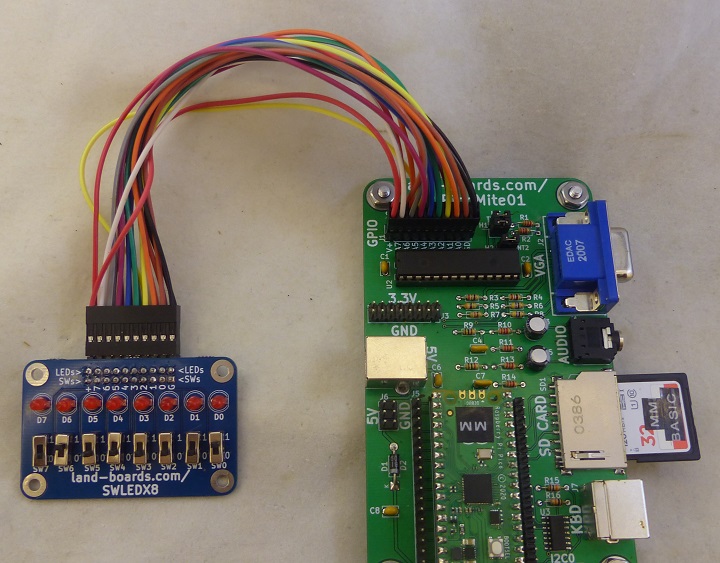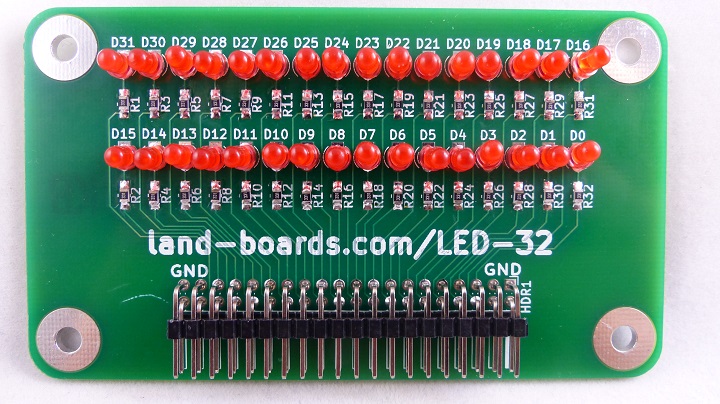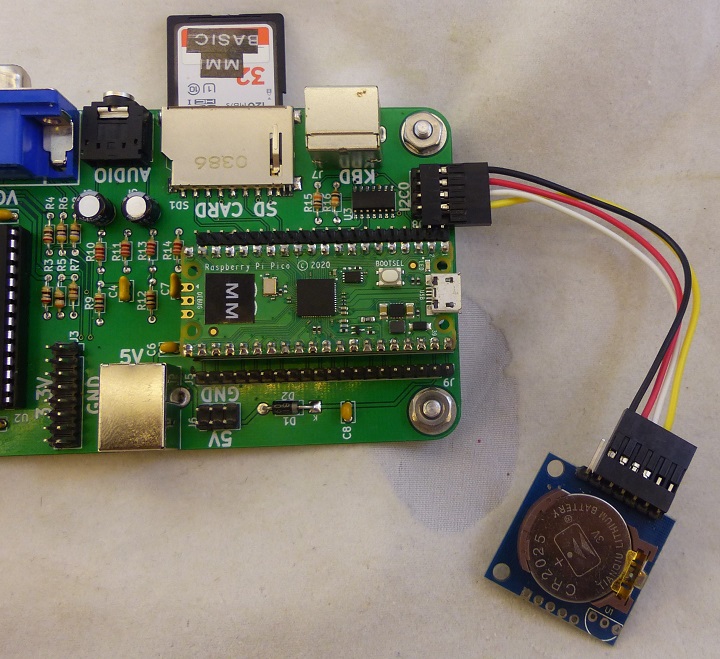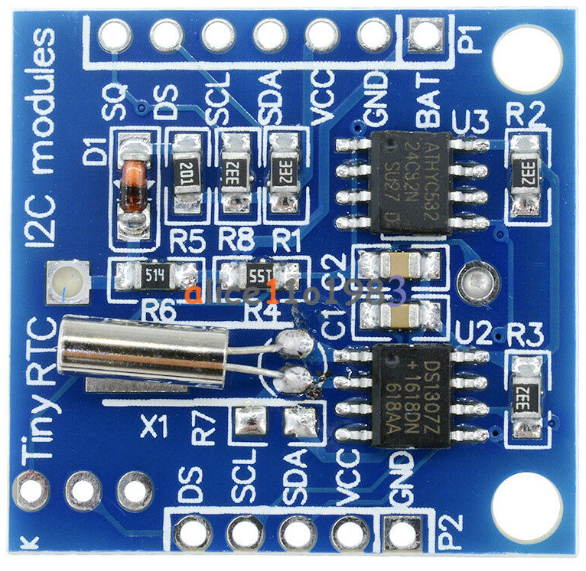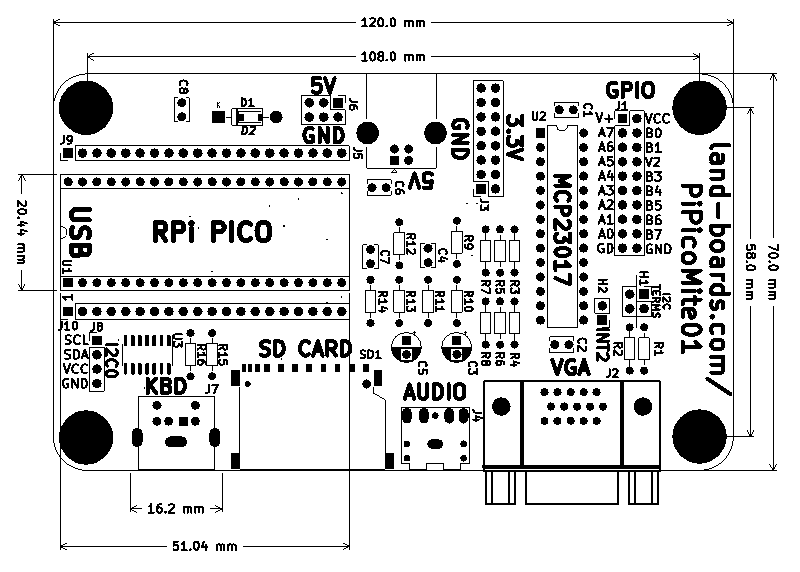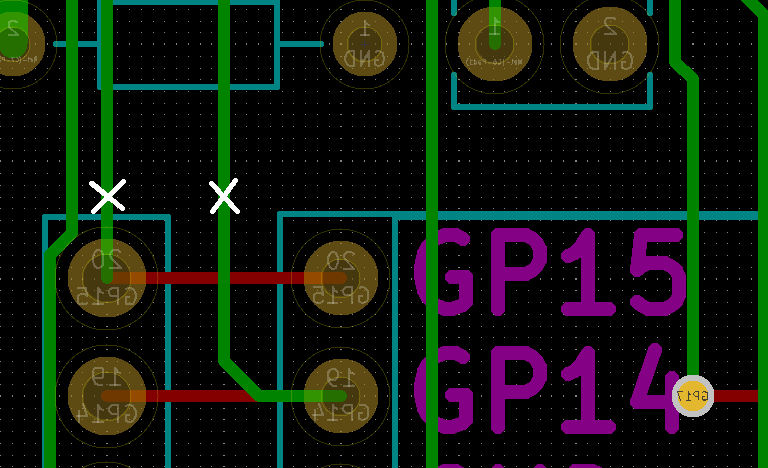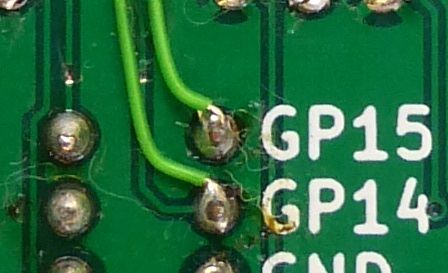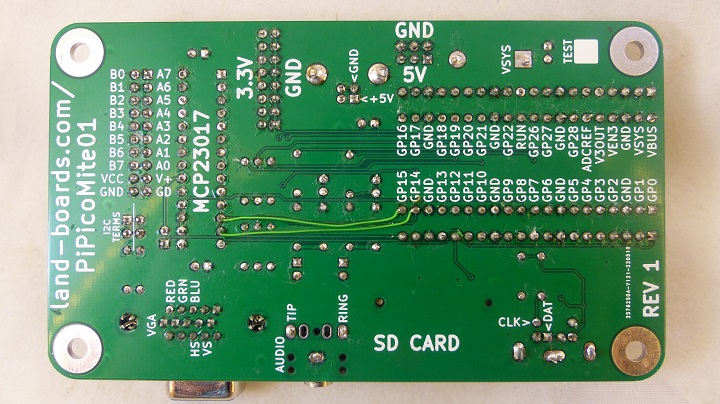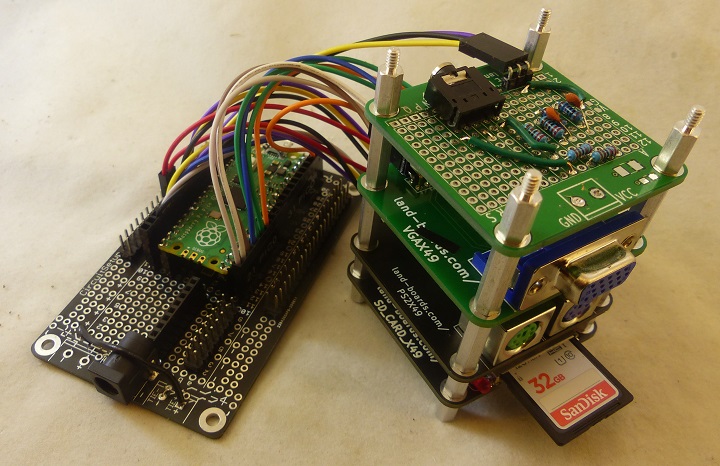Difference between revisions of "PiPicoMite01"
Blwikiadmin (talk | contribs) |
Blwikiadmin (talk | contribs) |
||
| (117 intermediate revisions by the same user not shown) | |||
| Line 4: | Line 4: | ||
<video type="youtube">5dcnrLDzjdU</video> | <video type="youtube">5dcnrLDzjdU</video> | ||
| + | |||
| + | == Card Versions == | ||
| + | |||
| + | * There are three versions of this card | ||
| + | ** [[PiPicoMite01]] (this version) | ||
| + | *** Has 16-bit port I/O expander | ||
| + | *** 120x70mm with (4) 6-32 mounting holes | ||
| + | ** [[PiPicoMite02]] | ||
| + | *** Has 32-bit port I/O expander(s) | ||
| + | *** 95x95mm with (4) 6-32 mounting holes | ||
| + | ** [[PiPicoMite03]] | ||
| + | *** 99.5x69.5mm - Fits into extruded Aluminum Enclosure | ||
| + | *** Fully functional, reduced cost | ||
== Features == | == Features == | ||
| Line 21: | Line 34: | ||
** Up to 32GB | ** Up to 32GB | ||
** FAT32 format | ** FAT32 format | ||
| + | ** [https://www.amazon.com/SanDisk-3-Pack-Ultra-Memory-3x32GB/dp/B08GY9575R/ref=sr_1_3?keywords=sandisk%2B32gb%2Bsd%2Bcard&qid=1657457739&sprefix=sandisk%2B32GB%2Caps%2C85&sr=8-3&th=1 Tested/worked] | ||
* Stereo audio | * Stereo audio | ||
** PWM with filter | ** PWM with filter | ||
** 3.5mm jack | ** 3.5mm jack | ||
| − | * 16 | + | ** [https://www.amazon.com/dp/B000R9AAJA?psc=1&ref=ppx_yo2ov_dt_b_product_details Cheap speakers] |
| − | ** [https://ww1.microchip.com/downloads/ | + | * 16 bit Port Expander |
| + | ** [https://ww1.microchip.com/downloads/aemDocuments/documents/APID/ProductDocuments/DataSheets/MCP23017-Data-Sheet-DS20001952.pdf MCP23017 Datasheet] - Rev D | ||
| + | ** [https://hackaday.com/2023/02/03/mcp23017-went-through-shortage-hell-lost-two-inputs/?fbclid=IwAR1ktG1CsU7ns5fmTYXdlpBLdqaJmBioXrVrG1_Lgqe8MTQr1AY4rp6IETU MCP23017... LOST TWO INPUTS] | ||
| + | *** MCP23017 now a 14/16-bit expander, with two of the pins (GPA7 and GPB7) losing their input capabilities | ||
| + | *** The chips look the same, are called the same, and act mostly the same — if you don’t download the latest version of the datasheet (Revision D), you’d never know that there’s been a change* 16-bit General Purpose I/O (GPIO) | ||
** On Pico I2C1 (I2C2 from MMBASIC) | ** On Pico I2C1 (I2C2 from MMBASIC) | ||
** 2x10 0.1" pitch header | ** 2x10 0.1" pitch header | ||
** Jumper selectable terminators | ** Jumper selectable terminators | ||
* I2C0 connector (Rev 2 and later) | * I2C0 connector (Rev 2 and later) | ||
| + | ** Requires external I2C terminators | ||
* Power options | * Power options | ||
** 5V power input | ** 5V power input | ||
| Line 41: | Line 60: | ||
=== BASIC Interpreter === | === BASIC Interpreter === | ||
| − | The PicoMiteVGA boots straight into the MMBasic prompt. At which point you can enter, edit and save the program, test BASIC commands and run the program. | + | The [https://geoffg.net/picomitevga.html PicoMiteVGA] boots straight into the MMBasic prompt. At which point you can enter, edit and save the program, test BASIC commands and run the program. |
| − | MMBasic is a Microsoft BASIC compatible implementation of the BASIC language, originally written by Geoff Graham and enhanced and ported to the Pico by Peter Mather, who also designed the original PicoMite on which | + | MMBasic is a Microsoft BASIC compatible implementation of the BASIC language, originally written by Geoff Graham and enhanced and ported to the Pico by Peter Mather, who also designed the original PicoMite on which this design is based. It is full featured with floating point, 64-bit integers and string variables, long variable names, arrays of floats, integers or strings with multiple dimensions, extensive string handling and user defined subroutines and functions. Typically it will execute a program up to 100,000 lines per second. Embedded compiled C programs can be used for even higher performance. |
Using MMBasic you can use communications protocols such as I2C or SPI to get data from a variety of sensors. You can save data to an SD card, measure voltages, detect digital inputs and drive output pins to turn on lights, relays, etc. | Using MMBasic you can use communications protocols such as I2C or SPI to get data from a variety of sensors. You can save data to an SD card, measure voltages, detect digital inputs and drive output pins to turn on lights, relays, etc. | ||
| Line 49: | Line 68: | ||
The emphasis with MMBasic is on ease of use and development. The development cycle is very fast with the ability to instantly switch from edit to run. Errors are listed in plain English and when an error does occur a single keystroke will invoke the built in editor with the cursor positioned on the line that caused the error. | The emphasis with MMBasic is on ease of use and development. The development cycle is very fast with the ability to instantly switch from edit to run. Errors are listed in plain English and when an error does occur a single keystroke will invoke the built in editor with the cursor positioned on the line that caused the error. | ||
| − | == Pinout == | + | ==== MMBASIC Credits ==== |
| + | |||
| + | Peter Mather led the [https://geoffg.net/picomitevga.html project], ported the MMBasic interpreter to the Raspberry Pi Pico and wrote the hardware device drivers. Geoff Graham wrote the MMBasic interpreter and the manual. Mick Ames wrote the PIO compiler and its corresponding documentation. The VGA driver code was derived from work by Miroslav Nemecek. | ||
| + | |||
| + | === Raspberry Pi Pico Pinout (Reference) === | ||
[[File:PiPico_Pins.PNG]] | [[File:PiPico_Pins.PNG]] | ||
| Line 74: | Line 97: | ||
=== J1 - MCP23017 - 16-bit GPIO === | === J1 - MCP23017 - 16-bit GPIO === | ||
| − | * [https://ww1.microchip.com/downloads/ | + | * [https://ww1.microchip.com/downloads/aemDocuments/documents/APID/ProductDocuments/DataSheets/MCP23017-Data-Sheet-DS20001952.pdf MCP23017 Datasheet] - Rev D |
| + | ** [https://hackaday.com/2023/02/03/mcp23017-went-through-shortage-hell-lost-two-inputs/?fbclid=IwAR1ktG1CsU7ns5fmTYXdlpBLdqaJmBioXrVrG1_Lgqe8MTQr1AY4rp6IETU MCP23017... LOST TWO INPUTS] | ||
| + | *** MCP23017 now a 14/16-bit expander, with two of the pins (GPA7 and GPB7) losing their input capabilities | ||
| + | *** The chips look the same, are called the same, and act mostly the same — if you don’t download the latest version of the datasheet (Revision D), you’d never know that there’s been a change | ||
* 2x10 header | * 2x10 header | ||
| − | * | + | ** 16 bits of Digital I/O |
| + | *** A0 silkscreen marking = GPA0, etc. | ||
| + | ** (2) Power | ||
| + | ** (2) Ground | ||
* On I2C2 pins (I2C1 on Pico) | * On I2C2 pins (I2C1 on Pico) | ||
** SetPin BASIC code | ** SetPin BASIC code | ||
| Line 87: | Line 116: | ||
* Initialization code | * Initialization code | ||
| + | * Set all pins to outputs | ||
<pre> | <pre> | ||
| Line 118: | Line 148: | ||
</pre> | </pre> | ||
| − | * Write alternating patterns | + | * Write alternating patterns on output pins |
<pre> | <pre> | ||
| Line 162: | Line 192: | ||
** [https://en.wikipedia.org/wiki/Line_level Line Level Audio information] | ** [https://en.wikipedia.org/wiki/Line_level Line Level Audio information] | ||
* [https://github.com/land-boards/RasPiPico/blob/main/PicoMite_MMBASIC/PicoMite_VGA/Land%20Boards%20BASIC%20Programs/testtone.bas Two Tone Test] | * [https://github.com/land-boards/RasPiPico/blob/main/PicoMite_MMBASIC/PicoMite_VGA/Land%20Boards%20BASIC%20Programs/testtone.bas Two Tone Test] | ||
| + | * Can get rid of noise using | ||
| + | |||
| + | <pre> | ||
| + | OPTION POWER PWM | ||
| + | </pre> | ||
| + | |||
* Play a WAV file | * Play a WAV file | ||
| + | |||
<pre> | <pre> | ||
OPTION AUDIO GP6, GP7 | OPTION AUDIO GP6, GP7 | ||
| Line 388: | Line 425: | ||
|- | |- | ||
|} | |} | ||
| − | |||
| − | |||
| − | |||
| − | |||
| − | |||
| − | |||
| − | |||
| − | |||
| − | |||
| − | |||
| − | |||
| − | |||
=== H1 - I2C Terminators === | === H1 - I2C Terminators === | ||
| Line 431: | Line 456: | ||
* MCP23017 interrupts can be set to generate interrupts on INTA pins for both A abd B ports | * MCP23017 interrupts can be set to generate interrupts on INTA pins for both A abd B ports | ||
* No Pull-up on card | * No Pull-up on card | ||
| + | |||
| + | === SD1 - SD Card === | ||
| + | |||
| + | The PicoMiteVGA firmware reserves eight program storage "slots" in the Raspberry Pi Pico flash memory. Programs can be saved and retreived from these without the need for any additional storage. | ||
| + | |||
| + | For more storage SD cards can be connected with full support for these built into MMBasic including the ability to open files for reading, writing or random access and loading and saving programs. SD cards connect directly to the Raspberry Pi Pico and the firmware will work with cards up to 32GB formatted in FAT16 or FAT32. The files created can be read and written on personal computers running Windows, Linux or the Mac operating system. | ||
| + | |||
| + | The option values are: | ||
| + | |||
| + | <pre> | ||
| + | OPTION SDCARD GP13, GP10, GP11, GP12 | ||
| + | </pre> | ||
| + | |||
| + | After entering the OPTION, the card will re-boot and the SD card should be accessible. | ||
| + | |||
| + | [https://github.com/land-boards/RasPiPico/tree/main/PicoMite_MMBASIC/PicoMite_VGA/Land%20Boards%20BASIC%20Programs Repository for SD Card files] | ||
| + | |||
| + | [[file:PiPicoMite01_J1_SD_Card.PNG]] | ||
== Configuration Options == | == Configuration Options == | ||
| Line 443: | Line 486: | ||
</pre> | </pre> | ||
| − | == | + | == PicoMiteVGA Software == |
| + | |||
| + | === Download MMBASIC === | ||
| + | |||
| + | * Tested with "VGA only" versions | ||
| + | ** Released [https://geoffg.net/Downloads/picomite/PicoMiteVGA_Firmware.zip V5.07.04] | ||
| + | ** Beta [https://www.thebackshed.com/forum/ViewTopic.php?FID=16&TID=14854#186644 V5.07.05b2] | ||
| + | ** [https://github.com/land-boards/RasPiPico/tree/main/PicoMite_MMBASIC/PicoMite_VGA/PicoMiteVGA_Firmware Copies of firmware versions] - some have unstable video mode 1 | ||
| + | * [https://www.thebackshed.com/forum/ViewTopic.php?TID=14854&P=1 TheBackShed MMBasic support forum] | ||
| + | * [http://www.fruitoftheshed.com/MMBasic.AllPages.aspx Fruit Of The Shed] - _MMBasic Code Library | ||
| + | * If the Pico does not already have MMBASIC installed | ||
| + | * Hold button on Pico while plugging in USB Micro to PC | ||
| + | * Drive will open | ||
| + | * Drop VGA uf2 onto Drive | ||
| + | * System will reboot | ||
| + | |||
| + | <pre> | ||
| + | > print mm.ver | ||
| + | 5.070502 | ||
| + | </pre> | ||
| + | |||
| + | * Run TeraTerm | ||
| + | ** Connect to Serial | ||
| + | |||
| + | === Configure MMBASIC === | ||
| − | * | + | * Setups |
| − | * | + | ** Can copy-paste a line at a time into TeraTerm |
| + | ** First two will reboot card | ||
| − | + | <pre> | |
| + | OPTION SDCARD GP13, GP10, GP11, GP12 | ||
| + | OPTION AUDIO GP6, GP7 | ||
| + | OPTION COLOURCODE ON | ||
| + | OPTION POWER PWM | ||
| − | + | </pre> | |
| − | + | * If an external RTC is attached to J1 | |
| − | + | <pre> | |
| + | OPTION SYSTEM I2C GP0,GP1 | ||
| + | </pre> | ||
| − | + | * Remove USB power | |
| + | * Install SD card | ||
| + | * Apply USB power | ||
=== PicoMite Source code === | === PicoMite Source code === | ||
| + | * It's not necessary to build the source code since there are .uf2 files | ||
* [https://github.com/UKTailwind/PicoMite/tree/main/PicoMite PicoMite Source code] | * [https://github.com/UKTailwind/PicoMite/tree/main/PicoMite PicoMite Source code] | ||
** [https://github.com/UKTailwind/PicoMite-VGA-Edition Extra/replacement files for VGA] | ** [https://github.com/UKTailwind/PicoMite-VGA-Edition Extra/replacement files for VGA] | ||
| − | === On-board | + | === On-board 16-bit Port Expander Example Code === |
| − | Example code that exercises the MCP23017 Port Expander on the PiPicoMite01 card. | + | [https://github.com/land-boards/RasPiPico/tree/main/PicoMite_MMBASIC/PicoMite_VGA/Land%20Boards%20BASIC%20Programs/On-Board_Digital_IO/PiPicoMite01 Example code] that exercises the MCP23017 Port Expander on the PiPicoMite01 card. |
* [https://ww1.microchip.com/downloads/en/devicedoc/20001952c.pdf MCP23017 Datasheet] | * [https://ww1.microchip.com/downloads/en/devicedoc/20001952c.pdf MCP23017 Datasheet] | ||
| − | * [https://github.com/land-boards/RasPiPico/blob/main/PicoMite_MMBASIC/PicoMite_VGA/Land%20Boards%20BASIC%20Programs/ | + | ==== MCP23017_Blinkey.bas ==== |
| − | ** Attach external LED | + | |
| − | * [https://github.com/land-boards/RasPiPico/blob/main/PicoMite_MMBASIC/PicoMite_VGA/Land%20Boards%20BASIC%20Programs/ | + | * [https://github.com/land-boards/RasPiPico/blob/main/PicoMite_MMBASIC/PicoMite_VGA/Land%20Boards%20BASIC%20Programs/On-Board_Digital_IO/PiPicoMite01/MCP23017_Blinkey.bas MCP23017_Blinkey.bas] |
| + | * Blink LED | ||
| + | ** Attach external LED | ||
| + | *** LED with series resistor + side to PORTA bit 0 (marked as A0) to - side GND (ground) | ||
| + | |||
| + | ==== MCP23017_Bits.bas ==== | ||
| + | |||
| + | * [https://github.com/land-boards/RasPiPico/blob/main/PicoMite_MMBASIC/PicoMite_VGA/Land%20Boards%20BASIC%20Programs/On-Board_Digital_IO/PiPicoMite01/MCP23017_Bits.bas MCP23017_Bits.bas] | ||
| + | * Good starting app to build Digital I/O apps on | ||
| + | ** Arduino-like, bit-wise control of on-board MCP23017 | ||
| + | ** [https://www.arduino.cc/reference/en/language/functions/digital-io/digitalread/ DigitalRead], [https://www.arduino.cc/reference/en/language/functions/digital-io/digitalwrite/ DigitalWrite], [https://www.arduino.cc/reference/en/language/functions/digital-io/pinmode/ PinMode] functions | ||
| + | * Application reads 8 switches and echos to 8 LEDs | ||
| + | * Uses [[SWLEDX8]] card | ||
| + | |||
| + | [[file:PiPicoMite01_P1080361_720px.jpg]] | ||
| + | |||
| + | ==== GPIO16-01.bas ==== | ||
| + | |||
| + | * [https://github.com/land-boards/RasPiPico/blob/main/PicoMite_MMBASIC/PicoMite_VGA/Land%20Boards%20BASIC%20Programs/On-Board_Digital_IO/PiPicoMite01/GPIO16-01.bas GPIO16-01.bas] | ||
** Set all 16 GPIO pins as outputs | ** Set all 16 GPIO pins as outputs | ||
** Write alternate patterns, bounce a 1 across the outputs | ** Write alternate patterns, bounce a 1 across the outputs | ||
| − | * [ | + | * Use with [[LED-32]] card |
| − | + | ||
| + | [[file:LED-32-P426-720px.jpg]] | ||
=== Land Boards Card Test Code === | === Land Boards Card Test Code === | ||
| + | |||
| + | <video type="youtube">BFAmXNDGFA0</video> | ||
==== MCP23017 on external cards ==== | ==== MCP23017 on external cards ==== | ||
| Line 498: | Line 596: | ||
** [https://github.com/land-boards/RasPiPico/blob/main/PicoMite_MMBASIC/PicoMite_VGA/Land%20Boards%20BASIC%20Programs/lbcards/I2CIO8/I2CIO8_Test.bas I2CIO8_Test.bas] - Card Test program | ** [https://github.com/land-boards/RasPiPico/blob/main/PicoMite_MMBASIC/PicoMite_VGA/Land%20Boards%20BASIC%20Programs/lbcards/I2CIO8/I2CIO8_Test.bas I2CIO8_Test.bas] - Card Test program | ||
| − | === Tetris === | + | === Blocks (Tetris) === |
<pre> | <pre> | ||
| Line 513: | Line 611: | ||
[[file:Pico_Tetris.jpg]] | [[file:Pico_Tetris.jpg]] | ||
| + | |||
| + | === CP/M on Raspberry Pi Pico === | ||
| + | |||
| + | * [https://github.com/ExtremeElectronics/RC2040 ExtremeElectronics GitHub] - Z80 RC2014 Emulation | ||
| + | * [https://www.extremeelectronics.co.uk/emulating-a-z80-rc2014-with-cpm-and-ide-drives-via-an-sd-card/ EMULATING A Z80 RC2014 WITH CPM AND IDE DRIVES VIA AN SD CARD] | ||
=== MMBASIC vs MicroPython Performance === | === MMBASIC vs MicroPython Performance === | ||
| Line 518: | Line 621: | ||
<video type="youtube">VFdXTYLX6PU</video> | <video type="youtube">VFdXTYLX6PU</video> | ||
| − | === | + | == CircuitPython on PiPicoMite0x Cards == |
| + | |||
| + | * The PiPicoMite0x cards can run CircuitPython with some limitations | ||
| + | * Card features for CircuitPython application | ||
| + | ** SD support | ||
| + | ** 1x MCP23017, 16-bit port expander | ||
| + | *** 2x10 header | ||
| + | ** 5V input | ||
| + | ** External I2C | ||
| + | * CircuitPython does not have built-in support for | ||
| + | ** VGA | ||
| + | ** PS/2 | ||
| + | ** Audio | ||
| + | |||
| + | === Thoughts on CircuitPython on PiPicoMite0x Cards === | ||
| + | |||
| + | To my way of thinking PicoMiteVGA build is two things. The first is a software build/port of MMBASIC a powerful piece of software with a rich legacy onto the RP2040 core. The second part is the hardware baseline for the PicoMiteVGA build. | ||
| + | |||
| + | By way of contrast, the folks that came up with the RP2040 Hardware Reference design made a set of design choices and Pico pin assignments. These rippled into the C++ SDK code base. The differences are largely in 2 areas - the SD card and VGA. The PS/2 interface is a 3rd area of difference. | ||
| + | |||
| + | Each approach picked a different method accessing the SD card. PicoMite and PicoMiteVGA chose the SPI method to connect to the SD card. The Hardware Reference design used the other method which uses more pins but it ostensibly "faster" since it accesses the card in a nibble mode. I think the Hardware Reference design made a poor choice since it takes more pins. It's faster, but not "necessary" since SD card speed isn't critical for the vast majority of applications and it's certainly not minimal. In short, it takes up pins of the Pico that are better reserved for other functions. | ||
| + | |||
| + | Similarly, the Pico Hardware Reference design chose 16-bit video and PicoMiteVGA chose 4 -bit video. PicoMiteVGA will never do photo-realistic images but it can do "enough" for most applications, particularly "retro" games. Most importantly, the PiPicoMiteVGA hardware saves a whole lot of pins of the Pico. The evidence that the Hardware Reference design is overkill is their dual use of the least significant video bits as inputs which they say don't affect video quality when you use them. So why have them if they don;t matter? I think they were building a showcase design and unconcerned about applications which might want to use pins on the Pico - they didn't leave many/any free. | ||
| + | |||
| + | So back to the original question. I envision a use of the hardware design of the PicoMiteVGA where the card does what it does so well in MMBASIC but also can be used in either Micro or Circuit Python(s). The Python(s) build has/needs three features. | ||
| + | |||
| + | # The PS/2 keyboard which is missing in the Hardware Reference design is presen in the PicMiteVGA designt. After all, why have a display for output but no means of input other than USB? No way to have a standalone design and still be tethered to the USB port. The PS/2 keyboard then replaces the USB for input. Ie, the Hardware Reference design is all showy output but no input. They provide nice video but just a couple of dual use buttons for controls. | ||
| + | # The SD card works just fine under the Python(s), It really just works under the Python(s) since that's the method they prefer anyway and they support it. I tried it, and it works. Again, it was another "showy" choice in the Reference design that allows boasting about SD performance but a poor choice for applications which want/need the extra pins. | ||
| + | # The VGA replaces the USB for output, It comes with the stated compromises of the number of bits but that's just fine for most cases (at least most of the cases I care about). In the end the same PicoMiteVGA hardware can be used for standalone applications in either MMBASIC or the Python(s). | ||
| + | |||
| + | The pieces that are "missing" (the PS/2 and VGA code) already exist as C++ code which can be [https://docs.micropython.org/en/latest/develop/cmodules.html#basic-example made into precompiled Python modules] - essentially wrappers to the C++ code that can be called from Python. It would be more work, probably involving messing with the Python kernel itself - to get things like print() working. It involves the same things that video modes and fonts on MMBASIC entailed. | ||
| + | |||
| + | If someone wants to run MMBASIC or one of the Python(s) on the same PicoMiteVGA hardware baseline, why not? It's a perfectly good hardware baseline for either. | ||
| − | + | === CircuitPython Digital I/O === | |
| − | |||
| − | |||
| − | |||
| − | |||
| − | |||
| − | |||
| − | |||
| − | + | * [https://github.com/land-boards/RasPiPico/blob/main/CircuitPython/CircuitPython_Code/digio16/Digio16Test.py PiPicoMite01_Digio16.py] | |
| + | ** Control the MCP23017 part on the PiPicoMite01 | ||
| + | ** Provides Arduino-like functions | ||
| − | |||
| − | |||
| − | |||
<pre> | <pre> | ||
| − | + | # digitalWrite(bit,value) | |
| − | + | # bit = 0-15 | |
| − | + | # value = 0, 1 | |
| + | # digitalRead(bit) | ||
| + | # bit = 0-15 | ||
| + | # returns 0, 1 | ||
| + | # pinMode(bit,value) | ||
| + | # bit = 0-15 | ||
| + | # value = INPUT, OUTPUT, INPUT_PULLUP | ||
| + | # pinMode(bit,value) | ||
</pre> | </pre> | ||
| − | |||
| − | |||
| − | |||
| − | |||
| − | |||
| − | * | + | * [https://github.com/land-boards/RasPiPico/blob/main/CircuitPython/CircuitPython_Code/digio16/PiPicoMite01_Digio16.py PiPicoMite01_Digio16.py] - Example code uses the PiPicoMite01_Digio16 library |
| − | |||
=== CircuitPython SD Card === | === CircuitPython SD Card === | ||
| Line 553: | Line 681: | ||
* [https://learn.adafruit.com/micropython-hardware-sd-cards/code-storage-on-sd-card Code Storage on SD Card] | * [https://learn.adafruit.com/micropython-hardware-sd-cards/code-storage-on-sd-card Code Storage on SD Card] | ||
* [https://github.com/land-boards/RasPiPico/blob/main/CircuitPython/CircuitPython_Code/SD_Card/SDCard_Dir.py SDCard_Dir.py] - List SD Card directory | * [https://github.com/land-boards/RasPiPico/blob/main/CircuitPython/CircuitPython_Code/SD_Card/SDCard_Dir.py SDCard_Dir.py] - List SD Card directory | ||
| − | * Pins | + | * Pins (from MMBASIC) |
<pre> | <pre> | ||
| − | |||
# OPTION SDCARD GP13, GP10, GP11, GP12 | # OPTION SDCARD GP13, GP10, GP11, GP12 | ||
# CS = GP13 | # CS = GP13 | ||
| Line 569: | Line 696: | ||
</pre> | </pre> | ||
| − | + | * Make directories | |
| − | * Test cards using this procedure | + | <pre> |
| + | >>> os.mkdir('/sd/CircuitPython/') | ||
| + | >>> os.mkdir('/sd/CircuitPython/SD_Card') | ||
| + | </pre> | ||
| + | |||
| + | * Add code to path | ||
| + | |||
| + | <pre> | ||
| + | >>> import sys | ||
| + | >>> sys.path | ||
| + | ['', '/', '.frozen', '/lib'] | ||
| + | >>> sys.path.append("/sd") | ||
| + | >>> sys.path | ||
| + | ['', '/', '.frozen', '/lib', '/sd'] | ||
| + | >>> os.listdir('/sd/CircuitPython/SD_Card') | ||
| + | [] | ||
| + | </pre> | ||
| + | |||
| + | == Factory Test Procedure == | ||
| + | |||
| + | * Test assembled cards using this procedure | ||
* MMBASIC is already set up on the card | * MMBASIC is already set up on the card | ||
| Line 580: | Line 727: | ||
* Stereo amplified speakers | * Stereo amplified speakers | ||
* PS/2 keyboard | * PS/2 keyboard | ||
| − | * | + | * MMBASIC SD card with contents |
| − | ** [https://github.com/land-boards/RasPiPico/tree/main/PicoMite_MMBASIC/PicoMite_VGA/Land%20Boards%20BASIC%20Programs Software repo] | + | ** [https://github.com/land-boards/RasPiPico/tree/main/PicoMite_MMBASIC/PicoMite_VGA/Land%20Boards%20BASIC%20Programs Test Software repo] |
| − | * Raspberry Pi Pico | + | * Raspberry Pi Pico with MMBASIC installed |
| − | * PC running TeraTerm | + | * PC running [http://www.teraterm.org/ TeraTerm] |
* If optional port expander is installed | * If optional port expander is installed | ||
** [[LED-32]] card | ** [[LED-32]] card | ||
** Cable from GPIO to [[LED-32]] card | ** Cable from GPIO to [[LED-32]] card | ||
| − | + | === Test SD card interface === | |
* Type | * Type | ||
| Line 608: | Line 755: | ||
</pre> | </pre> | ||
| − | + | === Test Sound === | |
| − | * Loads [https://github.com/land-boards/RasPiPico/blob/main/PicoMite_MMBASIC/PicoMite_VGA/Land%20Boards%20BASIC%20Programs/wave/sample4.wav | + | * Loads [https://github.com/land-boards/RasPiPico/blob/main/PicoMite_MMBASIC/PicoMite_VGA/Land%20Boards%20BASIC%20Programs/wave/sample4.wav sample4.wav file] |
* Type | * Type | ||
<pre> | <pre> | ||
| Line 624: | Line 771: | ||
</pre> | </pre> | ||
| − | + | === Test Keyboard === | |
* Type on keyboard | * Type on keyboard | ||
* Verify keys show up on VGA | * Verify keys show up on VGA | ||
| − | + | === Test VGA === | |
* Type | * Type | ||
| Line 648: | Line 795: | ||
</pre> | </pre> | ||
| − | ==== Test GPIO (Rev 2 card) (if optional MCP23017 is installed) | + | === Test 5V in === |
| + | |||
| + | * Connect USB B to 5V (or PC) | ||
| + | * Remove USB Micro cable | ||
| + | * Card should continue to run | ||
| + | |||
| + | === Test GPIO (Rev 2 card) (if optional MCP23017 is installed) === | ||
* Connect [[LED-32]] card to J1 | * Connect [[LED-32]] card to J1 | ||
| − | * Runs [https://github.com/land-boards/RasPiPico/blob/main/PicoMite_MMBASIC/PicoMite_VGA/Land%20Boards%20BASIC%20Programs/ | + | * Runs [https://github.com/land-boards/RasPiPico/blob/main/PicoMite_MMBASIC/PicoMite_VGA/Land%20Boards%20BASIC%20Programs/On-Board_Digital_IO/PiPicoMite01/GPIO16-01.bas GPIO16-01.bas] |
** Rev 1 card requires edit to reverse the following change | ** Rev 1 card requires edit to reverse the following change | ||
| Line 675: | Line 828: | ||
* Any key will stop the program | * Any key will stop the program | ||
| − | + | === Test I2C (Rev 2 card) === | |
| − | * | + | * Use DS1307 RTC ([https://www.ebay.com/sch/i.html?_from=R40&_trksid=p2380057.m570.l2632&_nkw=ds1307+rtc&_sacat=92074 ebay search]) attached to I2C J1 |
| − | |||
| − | |||
| − | + | [[file:PiPicoMite01_RTC_P1080357_Cropped_720px.jpg]] | |
| − | |||
| − | |||
[[FILE:PiPicoMite01_J8_I2C.PNG]] | [[FILE:PiPicoMite01_J8_I2C.PNG]] | ||
| Line 711: | Line 860: | ||
* Verify RTC time works | * Verify RTC time works | ||
| + | |||
| + | === Combined Copy/Paste === | ||
| + | |||
| + | * Above tests can be copy/pasted | ||
| + | |||
| + | <pre> | ||
| + | files | ||
| + | |||
| + | chdir "/wave" | ||
| + | play wav "sample4.wav" | ||
| + | |||
| + | play stop | ||
| + | |||
| + | chdir "/demos" | ||
| + | load "Colours.bas" | ||
| + | run | ||
| + | |||
| + | mode 1 | ||
| + | |||
| + | flash load 5 | ||
| + | run | ||
| + | |||
| + | option system i2c gp0, gp1 | ||
| + | rtc gettime | ||
| + | print time$ | ||
| + | </pre> | ||
| + | |||
| + | * If MCP23017 is installed | ||
| + | * [https://github.com/land-boards/RasPiPico/blob/main/PicoMite_MMBASIC/PicoMite_VGA/Land%20Boards%20BASIC%20Programs/On-Board_Digital_IO/PiPicoMite01/MCP23017_Bits.bas MCP23017_Bits.bas] | ||
| + | * Stored in Flash 5 | ||
| + | |||
| + | == Mechanicals == | ||
| + | |||
| + | [[file:PicoMite01_Rev2_Mechs.PNG]] | ||
== Issues == | == Issues == | ||
| Line 753: | Line 936: | ||
[[file:PiMicoMite01_P18202_720px_Jumpers.jpg]] | [[file:PiMicoMite01_P18202_720px_Jumpers.jpg]] | ||
| + | |||
| + | == Prototype Build == | ||
| + | |||
| + | <video type="youtube">gIK1ujslHHI</video> | ||
| + | |||
| + | * [[Raspberry Pi Pico MM BASIC Build]] | ||
| + | * Built from Land Boards cards | ||
| + | |||
| + | [[file:PicoMite_Proto_P18159_720px.jpg]] | ||
== Assembly Sheet == | == Assembly Sheet == | ||
| Line 758: | Line 950: | ||
* Make sure you build with the current revision assembly sheet | * Make sure you build with the current revision assembly sheet | ||
** Revision is marked on the rear of the card | ** Revision is marked on the rear of the card | ||
| + | * [[PiPicoMite01 Rev2 Assembly Sheet]] | ||
| + | * [http://land-boards.com/PiPicoMite01/PiPicoMite01_ibom_Rev2.html PiPicoMite01 Rev2 Interactive BOM] | ||
* [[PiPicoMite01 Rev1 Assembly Sheet]] | * [[PiPicoMite01 Rev1 Assembly Sheet]] | ||
| − | |||
Latest revision as of 19:37, 8 February 2023
Contents
- 1 Card Versions
- 2 Features
- 3 Pin Marking on Rear (Rev 2)
- 4 Schematic
- 5 Rev 1 Connectors
- 6 Rev 2 Connectors
- 7 Configuration Options
- 8 PicoMiteVGA Software
- 9 CircuitPython on PiPicoMite0x Cards
- 10 Factory Test Procedure
- 11 Mechanicals
- 12 Issues
- 13 Prototype Build
- 14 Assembly Sheet
Card Versions
- There are three versions of this card
- PiPicoMite01 (this version)
- Has 16-bit port I/O expander
- 120x70mm with (4) 6-32 mounting holes
- PiPicoMite02
- Has 32-bit port I/O expander(s)
- 95x95mm with (4) 6-32 mounting holes
- PiPicoMite03
- 99.5x69.5mm - Fits into extruded Aluminum Enclosure
- Fully functional, reduced cost
- PiPicoMite01 (this version)
Features
- Raspberry Pi Pico
- All Pico pins brought to headers
- Pico pin marking on rear
- VGA
- 640x480 monochrome resolution
- 320x240 colour resolution
- 1:2:1 - R:G:B - 16 colours
- PS/2 Keyboard
- 5V to keyboard with voltage translator
- Does not require a keyboard that runs at 3.3V
- SD Card
- Full size card
- Up to 32GB
- FAT32 format
- Tested/worked
- Stereo audio
- PWM with filter
- 3.5mm jack
- Cheap speakers
- 16 bit Port Expander
- MCP23017 Datasheet - Rev D
- MCP23017... LOST TWO INPUTS
- MCP23017 now a 14/16-bit expander, with two of the pins (GPA7 and GPB7) losing their input capabilities
- The chips look the same, are called the same, and act mostly the same — if you don’t download the latest version of the datasheet (Revision D), you’d never know that there’s been a change* 16-bit General Purpose I/O (GPIO)
- On Pico I2C1 (I2C2 from MMBASIC)
- 2x10 0.1" pitch header
- Jumper selectable terminators
- I2C0 connector (Rev 2 and later)
- Requires external I2C terminators
- Power options
- 5V power input
- USB Micro on Pico card
- USB B
- 0.1" pitch header
- 3.3V output header
- 5V power input
- 120mmx70mm outline
- (4) 6-32 Mounting holes
BASIC Interpreter
The PicoMiteVGA boots straight into the MMBasic prompt. At which point you can enter, edit and save the program, test BASIC commands and run the program.
MMBasic is a Microsoft BASIC compatible implementation of the BASIC language, originally written by Geoff Graham and enhanced and ported to the Pico by Peter Mather, who also designed the original PicoMite on which this design is based. It is full featured with floating point, 64-bit integers and string variables, long variable names, arrays of floats, integers or strings with multiple dimensions, extensive string handling and user defined subroutines and functions. Typically it will execute a program up to 100,000 lines per second. Embedded compiled C programs can be used for even higher performance.
Using MMBasic you can use communications protocols such as I2C or SPI to get data from a variety of sensors. You can save data to an SD card, measure voltages, detect digital inputs and drive output pins to turn on lights, relays, etc.
The emphasis with MMBasic is on ease of use and development. The development cycle is very fast with the ability to instantly switch from edit to run. Errors are listed in plain English and when an error does occur a single keystroke will invoke the built in editor with the cursor positioned on the line that caused the error.
MMBASIC Credits
Peter Mather led the project, ported the MMBasic interpreter to the Raspberry Pi Pico and wrote the hardware device drivers. Geoff Graham wrote the MMBasic interpreter and the manual. Mick Ames wrote the PIO compiler and its corresponding documentation. The VGA driver code was derived from work by Miroslav Nemecek.
Raspberry Pi Pico Pinout (Reference)
Pin Marking on Rear (Rev 2)
Schematic
Rev 1 Connectors
- PiPicoMite01 Rev 1 Connectors - Note the Rev 1 connectors are in different sequence orders than the Rev 2 and later cards
Rev 2 Connectors
- The following are for Rev 2 and later boards
J1 - MCP23017 - 16-bit GPIO
- MCP23017 Datasheet - Rev D
- MCP23017... LOST TWO INPUTS
- MCP23017 now a 14/16-bit expander, with two of the pins (GPA7 and GPB7) losing their input capabilities
- The chips look the same, are called the same, and act mostly the same — if you don’t download the latest version of the datasheet (Revision D), you’d never know that there’s been a change
- MCP23017... LOST TWO INPUTS
- 2x10 header
- 16 bits of Digital I/O
- A0 silkscreen marking = GPA0, etc.
- (2) Power
- (2) Ground
- 16 bits of Digital I/O
- On I2C2 pins (I2C1 on Pico)
- SetPin BASIC code
SetPin GP14, GP15, I2C2
- Initialization code
- Set all pins to outputs
MCP23017_I2CADR = &H20 MCP23017_IODIRA = &H00 MCP23017_IODIRB = &H01 MCP23017_IPOLA = &H02 MCP23017_IPOLB = &H03 MCP23017_GPINTENA = &H04 MCP23017_GPINTENB = &H05 MCP23017_DEFVALA = &H06 MCP23017_DEFVALB = &H07 MCP23017_INTCONA = &H08 MCP23017_INTCONB = &H09 MCP23017_IOCON = &H0A MCP23017_GPPUA = &H0C MCP23017_GPPUB = &H0D MCP23017_INTFA = &H0E MCP23017_INTFB = &H0F MCP23017_INTCAPA = &H10 MCP23017_INTCAPB = &H11 MCP23017_GPIOA = &H12 MCP23017_GPIOB = &H13 MCP23017_OLATA = &H14 MCP23017_OLATB = &H15 SetPin GP14, GP15, I2C2 I2C2 OPEN 400, 100 I2C2 WRITE MCP23017_I2CADR, 0, 2, MCP23017_IODIRA, &H00 I2C2 WRITE MCP23017_I2CADR, 0, 2, MCP23017_IODIRB, &H00
- Write alternating patterns on output pins
' Alternating patterns I2C2 WRITE MCP23017_I2CADR, 0, 2, MCP23017_OLATA, &H55 I2C2 WRITE MCP23017_I2CADR, 0, 2, MCP23017_OLATB, &HAA Pause 1000 I2C2 WRITE MCP23017_I2CADR, 0, 2, MCP23017_OLATA, &HAA I2C2 WRITE MCP23017_I2CADR, 0, 2, MCP23017_OLATB, &H55 Pause 200 I2C2 WRITE MCP23017_I2CADR, 0, 2, MCP23017_OLATA, &H00 I2C2 WRITE MCP23017_I2CADR, 0, 2, MCP23017_OLATB, &H00
J2 - VGA
The VGA output is 640 x 480 pixels in monochrome mode or 320 x 240 pixels in colour mode with 16 colours (1 bit for red, 2 bits for green and 1 bit for blue). The VGA output is generated using the second CPU on the RP2040 processor plus one PIO channel so it does not affect the BASIC interpreter which runs at full speed on the first CPU. A handfull of components (resistors and a couple of diodes) is all that is required to connect the VGA monitor.
From within your BASIC program you can turn pixels on/off and draw lines, boxes and circles in any colour. Text can be positioned anywhere on the screen and displayed in any colour in a variety of fonts.
The built-in editor within MMBasic works perfectly with the VGA monitor and PS2 keyboard to allow programs to be edited (with colour coded text) and saved to an SD card.
Mode 1 (640x480 monochrome) and mode 2 (320x240 16-colours).
OPTION COLOURCODE ON
J3 - 3.3V Power Out
- Power external interfaces
- Limits of the RT6150 regulator on the Pico
J4 - Audio
- Low Pass filter
- Resistive voltage divider to get to line level
- Two Tone Test
- Can get rid of noise using
OPTION POWER PWM
- Play a WAV file
OPTION AUDIO GP6, GP7 PLAY WAV "file.wav" PLAY STOP
J5 - USB B Power Connector
- In parallel with J6
- Full size USB B connector
- No USB signal connections, just used for power
J6 - 5V Input
- Useful to power the card from external 5V
- Use in place of J5
J7 - PS/2 Keyboard
The PS2 keyboard connects to the Raspberry Pi Pico via a level shifter and works as a normal keyboard with the function keys and arrow keys fully operational. It can be configured for the standard US layout used in the USA, Australia and New Zealand or specialised layouts used in the United Kingdom, Germany, France and Spain.
- 5V keyboard
J8 - I2C0, UART0 (RTC, etc.)
- I2C0SCL. UART0_TX (GP1)
- I2C0SDA. UART0_RX (GP0)
- VCC
- GND
Can use Real Time Clocks using the PCF8563, DS1307, DS3231 or DS3232 chips means that the time is always accurately known.
option system i2c gp0, gp1
J9, J10 Pico Connectors
- Pico pins are brought out to 1x20 pin headers J9, J10
Pico Function Mapping
| GP | FUNCTION | PICO PIN | GP | FUNCTION | PICO PIN | |
|---|---|---|---|---|---|---|
| GP0 | J8-2 (I2C0_SDA) | 1 | GP16 | VGA_HSYNC | 21 | |
| GP1 | J8-1 (I2C0_SCL) | 2 | GP17 | VGA_VSYNC | 22 | |
| GND | 3 | GND | 23 | |||
| GP2 | MCP23017_INTA (H2) | 4 | GP18 | VGA_BLU | 24 | |
| GP3 | SPARE GPIO | 5 | GP19 | VGA_GRN_LO | 25 | |
| GP4 | SPARE GPIO | 6 | GP20 | VGA_GRN_HI | 26 | |
| GP5 | SPARE GPIO | 7 | GP21 | VGA_RED | 27 | |
| GND | 8 | GND | 28 | |||
| GP6 | AUDIO-L | 9 | GP22 | SPARE GPIO | 29 | |
| GP7 | AUDIO-R | 10 | RUN | 30 | ||
| GP8 | PS2_CLK | 11 | GP26 | SPARE GPIO | 31 | |
| GP9 | PS2_DATA | 12 | GP27 | SPARE GPIO | 32 | |
| GND | 13 | GND | 33 | |||
| GP10 | SD_SCK | 14 | GP28 | SPARE GPIO | 34 | |
| GP11 | SD_MOSI | 15 | ADCREF | 35 | ||
| GP12 | SD_MISO | 16 | 3.3V | POWER_3.3V | 36 | |
| GP13 | SD_SLVSEL | 17 | VEN3 | 37 | ||
| GND | 18 | GND | 38 | |||
| GP14 | I2C1_SDA (MCP23017) | 19 | VSYS | PS2_5V | 39 | |
| GP15 | I2C1_SCL (MCP23017) | 20 | VBUS | 40 |
H1 - I2C Terminators
- 2.2K terminators
- Install shunts to terminate SDA, SCL signals that go to the on-board MCP23017 I2C Expander
- Terminators are normally installed at the end of daisy-chained cards
- I2C1 on Raspberry Pi Pico pins
- I2C2 from MM BASIC
- MM BASIC example commands
DIM BUFF(1) SETPIN GP14, GP15, I2C2 I2C2 OPEN 400, 100 I2C2 WRITE &H20, OC, LEN, B0[, B1...] I2C2 READ &H20, OX, LEN, BUFF()
- &H20 - I2C Address 0x20
- OC: 0=terminate after, 1=chain next
- len - Length of buffer (normally 1 for receive)
- B0,B1... Bytes to send
- BUFF() - receive buffer
H2 - MCP23017 - I2C Interrupt
- Install shunt to connect INTA interrupt from MCP23017 to GP2 on Pico
- MCP23017 interrupts can be set to generate interrupts on INTA pins for both A abd B ports
- No Pull-up on card
SD1 - SD Card
The PicoMiteVGA firmware reserves eight program storage "slots" in the Raspberry Pi Pico flash memory. Programs can be saved and retreived from these without the need for any additional storage.
For more storage SD cards can be connected with full support for these built into MMBasic including the ability to open files for reading, writing or random access and loading and saving programs. SD cards connect directly to the Raspberry Pi Pico and the firmware will work with cards up to 32GB formatted in FAT16 or FAT32. The files created can be read and written on personal computers running Windows, Linux or the Mac operating system.
The option values are:
OPTION SDCARD GP13, GP10, GP11, GP12
After entering the OPTION, the card will re-boot and the SD card should be accessible.
Configuration Options
> OPTION LIST OPTION COLOURCODE ON OPTION KEYBOARD US OPTION SDCARD GP13, GP10, GP11, GP12 OPTION AUDIO GP6,GP7, ON PWM CHANNEL 3 option system i2c gp0, gp1
PicoMiteVGA Software
Download MMBASIC
- Tested with "VGA only" versions
- Released V5.07.04
- Beta V5.07.05b2
- Copies of firmware versions - some have unstable video mode 1
- TheBackShed MMBasic support forum
- Fruit Of The Shed - _MMBasic Code Library
- If the Pico does not already have MMBASIC installed
- Hold button on Pico while plugging in USB Micro to PC
- Drive will open
- Drop VGA uf2 onto Drive
- System will reboot
> print mm.ver 5.070502
- Run TeraTerm
- Connect to Serial
Configure MMBASIC
- Setups
- Can copy-paste a line at a time into TeraTerm
- First two will reboot card
OPTION SDCARD GP13, GP10, GP11, GP12 OPTION AUDIO GP6, GP7 OPTION COLOURCODE ON OPTION POWER PWM
- If an external RTC is attached to J1
OPTION SYSTEM I2C GP0,GP1
- Remove USB power
- Install SD card
- Apply USB power
PicoMite Source code
- It's not necessary to build the source code since there are .uf2 files
- PicoMite Source code
On-board 16-bit Port Expander Example Code
Example code that exercises the MCP23017 Port Expander on the PiPicoMite01 card.
MCP23017_Blinkey.bas
- MCP23017_Blinkey.bas
- Blink LED
- Attach external LED
- LED with series resistor + side to PORTA bit 0 (marked as A0) to - side GND (ground)
- Attach external LED
MCP23017_Bits.bas
- MCP23017_Bits.bas
- Good starting app to build Digital I/O apps on
- Arduino-like, bit-wise control of on-board MCP23017
- DigitalRead, DigitalWrite, PinMode functions
- Application reads 8 switches and echos to 8 LEDs
- Uses SWLEDX8 card
GPIO16-01.bas
- GPIO16-01.bas
- Set all 16 GPIO pins as outputs
- Write alternate patterns, bounce a 1 across the outputs
- Use with LED-32 card
Land Boards Card Test Code
MCP23017 on external cards
Code to test Land Boards cards which have MCP23017 parts.
- PROTO16-I2C card
- GPIO16-02.bas
- Set all 16 GPIO pins as outputs
- Write alternate patterns, bounce a 1 across the outputs
- On SWLEDX8-I2C card
- swledx8-03.bas
- Read switches, write LEDs
MCP23008 Demo Code
- MCP23008 Datasheet
- I2CIO-8 card
- MMBASIC code - GitHub repo
- I2CIO8_Test.bas - Card Test program
Blocks (Tetris)
> memory Program: 13K (10%) Program (485 lines) 95K (90%) Free RAM: 8K ( 5%) 31 Variables 0K ( 0%) General 132K (95%) Free
CP/M on Raspberry Pi Pico
- ExtremeElectronics GitHub - Z80 RC2014 Emulation
- EMULATING A Z80 RC2014 WITH CPM AND IDE DRIVES VIA AN SD CARD
MMBASIC vs MicroPython Performance
CircuitPython on PiPicoMite0x Cards
- The PiPicoMite0x cards can run CircuitPython with some limitations
- Card features for CircuitPython application
- SD support
- 1x MCP23017, 16-bit port expander
- 2x10 header
- 5V input
- External I2C
- CircuitPython does not have built-in support for
- VGA
- PS/2
- Audio
Thoughts on CircuitPython on PiPicoMite0x Cards
To my way of thinking PicoMiteVGA build is two things. The first is a software build/port of MMBASIC a powerful piece of software with a rich legacy onto the RP2040 core. The second part is the hardware baseline for the PicoMiteVGA build.
By way of contrast, the folks that came up with the RP2040 Hardware Reference design made a set of design choices and Pico pin assignments. These rippled into the C++ SDK code base. The differences are largely in 2 areas - the SD card and VGA. The PS/2 interface is a 3rd area of difference.
Each approach picked a different method accessing the SD card. PicoMite and PicoMiteVGA chose the SPI method to connect to the SD card. The Hardware Reference design used the other method which uses more pins but it ostensibly "faster" since it accesses the card in a nibble mode. I think the Hardware Reference design made a poor choice since it takes more pins. It's faster, but not "necessary" since SD card speed isn't critical for the vast majority of applications and it's certainly not minimal. In short, it takes up pins of the Pico that are better reserved for other functions.
Similarly, the Pico Hardware Reference design chose 16-bit video and PicoMiteVGA chose 4 -bit video. PicoMiteVGA will never do photo-realistic images but it can do "enough" for most applications, particularly "retro" games. Most importantly, the PiPicoMiteVGA hardware saves a whole lot of pins of the Pico. The evidence that the Hardware Reference design is overkill is their dual use of the least significant video bits as inputs which they say don't affect video quality when you use them. So why have them if they don;t matter? I think they were building a showcase design and unconcerned about applications which might want to use pins on the Pico - they didn't leave many/any free.
So back to the original question. I envision a use of the hardware design of the PicoMiteVGA where the card does what it does so well in MMBASIC but also can be used in either Micro or Circuit Python(s). The Python(s) build has/needs three features.
- The PS/2 keyboard which is missing in the Hardware Reference design is presen in the PicMiteVGA designt. After all, why have a display for output but no means of input other than USB? No way to have a standalone design and still be tethered to the USB port. The PS/2 keyboard then replaces the USB for input. Ie, the Hardware Reference design is all showy output but no input. They provide nice video but just a couple of dual use buttons for controls.
- The SD card works just fine under the Python(s), It really just works under the Python(s) since that's the method they prefer anyway and they support it. I tried it, and it works. Again, it was another "showy" choice in the Reference design that allows boasting about SD performance but a poor choice for applications which want/need the extra pins.
- The VGA replaces the USB for output, It comes with the stated compromises of the number of bits but that's just fine for most cases (at least most of the cases I care about). In the end the same PicoMiteVGA hardware can be used for standalone applications in either MMBASIC or the Python(s).
The pieces that are "missing" (the PS/2 and VGA code) already exist as C++ code which can be made into precompiled Python modules - essentially wrappers to the C++ code that can be called from Python. It would be more work, probably involving messing with the Python kernel itself - to get things like print() working. It involves the same things that video modes and fonts on MMBASIC entailed.
If someone wants to run MMBASIC or one of the Python(s) on the same PicoMiteVGA hardware baseline, why not? It's a perfectly good hardware baseline for either.
CircuitPython Digital I/O
- PiPicoMite01_Digio16.py
- Control the MCP23017 part on the PiPicoMite01
- Provides Arduino-like functions
# digitalWrite(bit,value) # bit = 0-15 # value = 0, 1 # digitalRead(bit) # bit = 0-15 # returns 0, 1 # pinMode(bit,value) # bit = 0-15 # value = INPUT, OUTPUT, INPUT_PULLUP # pinMode(bit,value)
- PiPicoMite01_Digio16.py - Example code uses the PiPicoMite01_Digio16 library
CircuitPython SD Card
- Adafruit CircuitPython Module Install
- Code Storage on SD Card
- SDCard_Dir.py - List SD Card directory
- Pins (from MMBASIC)
# OPTION SDCARD GP13, GP10, GP11, GP12 # CS = GP13 # SCK = GP10 # MOSI = GP11 # MISO = GP12 spi = busio.SPI(board.GP10, MOSI=board.GP11, MISO=board.GP12) cs = board.GP13 sdcard = sdcardio.SDCard(spi, cs)
- Make directories
>>> os.mkdir('/sd/CircuitPython/')
>>> os.mkdir('/sd/CircuitPython/SD_Card')
- Add code to path
>>> import sys
>>> sys.path
['', '/', '.frozen', '/lib']
>>> sys.path.append("/sd")
>>> sys.path
['', '/', '.frozen', '/lib', '/sd']
>>> os.listdir('/sd/CircuitPython/SD_Card')
[]
Factory Test Procedure
- Test assembled cards using this procedure
- MMBASIC is already set up on the card
Equipment
- Unit Under Test (UUT)
- VGA monitor
- Stereo amplified speakers
- PS/2 keyboard
- MMBASIC SD card with contents
- Raspberry Pi Pico with MMBASIC installed
- PC running TeraTerm
- If optional port expander is installed
Test SD card interface
- Type
files
- Returns
A:/ <DIR> basic <DIR> bmps <DIR> demos <DIR> games <DIR> jpegs <DIR> lbcards <DIR> performance <DIR> wave 8 directories, 0 files
Test Sound
- Loads sample4.wav file
- Type
chdir "/wave" play wav "sample4.wav"
- Verify sound comes out of both speakers
- Stop with
play stop
Test Keyboard
- Type on keyboard
- Verify keys show up on VGA
Test VGA
- Type
chdir "/demos" load "Colours.bas" run
- Verify 16 distinct colors on VGA
- Type
mode 1
Test 5V in
- Connect USB B to 5V (or PC)
- Remove USB Micro cable
- Card should continue to run
Test GPIO (Rev 2 card) (if optional MCP23017 is installed)
- Connect LED-32 card to J1
- Runs GPIO16-01.bas
- Rev 1 card requires edit to reverse the following change
- Type
chdir "/lbcards/GPIO16" load "gpio16-01.bas" run
- Board will display
Looping through LEDs Hit a key to stop
- Verify that all LEDs blink
- Any key will stop the program
Test I2C (Rev 2 card)
- Use DS1307 RTC (ebay search) attached to I2C J1
- I2C0SCL wired to RTC SCL
- I2C0SDA wired to RTC SDA
- VCC wired to RTC VCC
- GND wired to RTC GND
- If RTC is not configured, type
option system i2c gp0, gp1 rtc settime YYYY, MM, DD, HH, MM, SS
- Check time
rtc gettime print time$
- Verify RTC time works
Combined Copy/Paste
- Above tests can be copy/pasted
files chdir "/wave" play wav "sample4.wav" play stop chdir "/demos" load "Colours.bas" run mode 1 flash load 5 run option system i2c gp0, gp1 rtc gettime print time$
- If MCP23017 is installed
- MCP23017_Bits.bas
- Stored in Flash 5
Mechanicals
Issues
Rev 2
- Re-sequenced jacks and capacitors reference designators to left-to-right/top-to-bottom order
- In sequential order for easier finding during assembly
- Fixed on-board MCP23017 I2C SDA/SCL pins order
- Added I2C Interface Header
- Moved Vcc to the end of the GPIO connector
- Checkout showed card is fully functional with no rework
Rev 1
- Tested and working
- Pico boots and runs
- VGA passes Colours.bas test
- PS/2 can type
- SD Card loads files
- Audio plays wav files
Issue with I2C connections to MCP23017 - Rework
- SDA, SCL swapped to MCP23017
- Cut etch solder side Pico pin 19 (to U2-12)
- Cut etch solder side Pico pin 20 (to U2-13)
- Cuts are done on rear side (CAD)
- Verify cuts with ohmmeter
- Cuts shown on board (using sharp Xacto knife)
- Jumpers
- Add wire Pico pin 19 to U2-13 (GP14)
- Add wire Pico pin 20 to U2-12 (GP15)
- Glue down wires with small dots of Superglue
Prototype Build
- Raspberry Pi Pico MM BASIC Build
- Built from Land Boards cards
Assembly Sheet
- Make sure you build with the current revision assembly sheet
- Revision is marked on the rear of the card
- PiPicoMite01 Rev2 Assembly Sheet
- PiPicoMite01 Rev2 Interactive BOM
- PiPicoMite01 Rev1 Assembly Sheet


